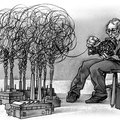HOUSTON — Maybe it is a new form of cultural colonialism or a sign of its demise, but the term “American artist” is becoming more inclusive, and museums in the southern and southwestern United States are helping. Six years ago the Museum of Fine Arts here established an International Center for Arts of the Americas to study 20th-century Latin American art. And it has made an enormous commitment to the short, intense career of the Brazilian artist Hélio Oiticica (1937-80).
The first fruit of this endeavor is “Hélio Oiticica: The Body of Color,” an exhilarating survey that emphasizes the earlier, lesser-known stages of this artist’s career — a rapid progression from abstract paintings to painted reliefs and objects to performance props and interactive installation art — which was fueled by a passion for color as theoretical as it was obsessive.
This show is like a large stone dropped into the calm waters of European-American art history. With its thick, lavishly illustrated catalog, it presents an enormously productive artist, writer and thinker whose work effortlessly spans the gap between Modern and Postmodern, Minimal and Post-Minimal. Reflecting inspirations from Mondrian to the samba music of Rio de Janeiro’s favelas (slums), it also bridges first- and third-world cultures in a way that has seldom been equaled.
The exhibition also looks gorgeous in the glass-and-steel addition Mies van der Rohe designed for the museum in the 1950s: the openness, natural light and spacious proportions perfectly suit the extravagant flow of Oiticica’s art. The show’s 220 objects span 25 years and include Oiticica’s cape-like parangoles of the late 1960s. Made of richly colored fabrics, these are meant to be worn in parades or while dancing the samba or in moments of private, slow-motion reverie (as the artist demonstrates on a video).
But the dominant works here are the paintings, two-sided reliefs and painted, boxlike sculptures that Oiticica (the name is pronounced Oy-ta-seeka) made from 1955 to 1966. They trace his step-by-step progress from a precocious teenager steeped in the work of Klee, Mondrian and Kandinsky to an innovator whose use of color and materials share aspects of work by Donald Judd, Yves Klein, Lucio Fontana and James Lee Byars.
The exhibition was organized under the direction of Mari Carmen Ramírez, the museum’s curator of Latin American art and the founding director of its International Center for the Arts of the Americas. She is the editor of the seven-volume Oiticica catalogue raisonnée, which the museum will soon begin publishing. (Both projects are collaborations with Projeto Hélio Oiticica in Rio de Janeiro, a foundation established by Oiticica’s two younger brothers, also artists, a year after his death.)
Sometime over the next five years Ms. Ramirez will also organize “Hélio Oiticica: The Space of the Senses,” which will address the dematerialized, anti-art efforts for which Oiticica is better known. That show will include works like the walk-in beach-hut environments that dominated “Tropicalia” at the Bronx Museum of Art earlier this season.
Born into Brazil’s leftist intelligentsia, Oiticica was a driven, rebellious prodigy whose talents were fostered by his parents, especially his father (an engineer, mathematics teacher and entomologist who was also one of Brazil’s first experimental photographers). The young Hélio further benefited from the concerted postwar effort among Brazil’s artists, designers and architects to keep pace with international culture, which included a rapid and self-conscious assimilation of aspects of Russian Constructivism and Neo-Plasticism.
In 1954 Oiticica began studying painting with Ivan Serpa, who had just helped found the Grupo Frente, a circle of abstract artists that included Lygia Clark and Lygia Pape. He started exhibiting with them in 1955. He later joined and showed with the Neo-Concrete group that Clark helped form. Yesterday the Museum of Fine Arts announced a significant gain in this area with the acquisition of the Adolpho Leirner Collection of Brazilian Constructive Art, which has lent two works to this show.
Oiticica’s career is a game of catch-up that moves with almost breakneck speed from conservative to radical and from derivative to original. (He once wrote that his work before 1959 should be ignored.) In the first third of the exhibition, works from 1955 to 1958, Oiticica simultaneously reviews and presages the vocabulary of Modernist abstraction, from Malevich, Klee and Jean Arp to Ellsworth Kelly and Mel Bochner. Made in gouache on cardboard, these works are small, delicate and often luminous. They use progressively fewer colors, and most share one quality: they are composed of separate shapes and have a kinetic buzz that suggests movement.
In the next third of the show, movement becomes real. This section begins with small monochromes in shades of red on small wood squares that are as much objects as paintings. It proceeds to the “Bilaterals” and “Spatial Reliefs,” two-sided, hanging painted wood pieces whose thin, seemingly folded forms might have been made a dozen years later by Dorothea Rockburne or Richard Tuttle. It culminates in the splendid marigold “Nuclei” of 1960-63, an arrangement of hanging squares and rectangles that form a porous maze (which originally people walked through).
At the heart of the show is an expanse of Oiticica’s “Bolides” from the early 1960s: dozens of the largely monochrome painted wood boxes, which were meant to be handled. Equipped with doors, shelves and drawers, they might incorporate glass vessels and hold caches of bright pigments, fabric, liquids, sand or crushed shells.
Low-tech, clearly hand-built and beguiling, the “Bolides” are the opposite of Minimal sculpture’s usual stand-offish perfection and reliance on predetermined systems. They make you want to reposition their moveable parts to understand them better. But even untouched, they render the whole idea of monochrome inoperative. Their colors vary slightly from plane to plane and also change as the adjustable parts catch light or shadow, or accent texture. The “Bolides” suggest a strange collaboration between Joseph Cornell, Josef Albers and Alan Shields — a kind of hedonistic, Fluxus-flavored formalism — and maintain a beautiful balance between chromatic purity and the eroding, workaday world
By focusing on Oiticica the consummate yet subversive maker of objects, who kept meticulous records about his artistic activities, this show may be an argument against the ephemeral in art. This Oiticica, so much livelier and present than the Oiticica of the capes and beach huts, is less familiar, partly because he disliked selling his work — at his death he owned perhaps 95 percent of it.
But the market’s loss is art history’s gain. An important component of the museum’s effort has been a huge conservation project. Most works here have been newly restored, and many have not been exhibited since the artist’s death. Paralleling this effort has been the archiving of the extensive papers he left behind, making possible the sometimes illuminating, sometimes pontificating excerpts in the show’s catalog. (At one point he equates his relationship to Mondrian with Cubism’s to Cézanne.)
Some of the more impressive writings dissect brushwork and paint texture and their relationship to visual perception in a way that is rare in modernist art writing. There is, in fact, a neat encapsulation of the meaning of painterly touch so basic to all of Oiticica’s art: “Texture is a product of intelligence, rarely one of intuition.”





